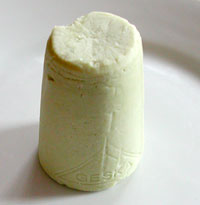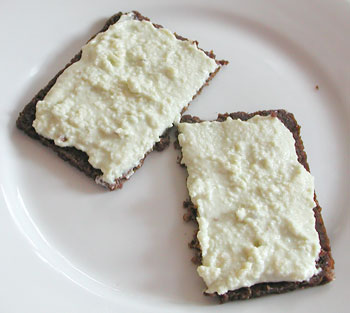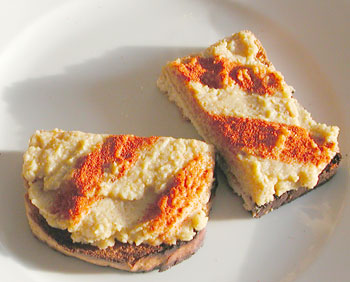Is my blog burning: tartine edition (with a recipe for hummus)
I wasn't too well prepared for the tartine edition (hosted by Clotilde of Chocolate and Zucchini) of Is My Blog Burning? (conceived by Alberto of Il Forno). I forgot to buy any special bread, so had to make do with regular toast bread and some pumpernickel. The pumpernickel was not toasted but the sliced white bread was. Then there was the matter of what to put on the bread. We sort of improvised, with mixed results. Therefore, a 2-for-1: choose the one that appeals to you the most!
Tartine 1: Luusesalbi. "I'll make some Luusesalbi" declared Max. Luusesalbi literally means Lice Cream...a somewhat worrisome name. It is made with a very strange Swiss cheese called Schabziger (there is a variety of it called Sapsago which may be more readily available outside of Switzerland). It originates in the canton of Glarus. It's made of skimmed milk, salt, and a mixture of alpine herbs. It is a pale lime green, and comes in little cones wrapped in foil:

Max grated the Schabziger into a bowl, and blended it with about 25 grams (about 2 tablespoons) of softened butter and a tablespoon of milk, with a fork. What emerged was this pale green paste, which was spread on the pumpernickel:

I took a bite - and suddenly remembered why I hadn't had this for more than 5 years. To me, it tastes somewhat like soap. Max however loves it. Maybe it's an acquired (Swiss) taste. If you want to try a very unusual cheese, you may want to give this a go. The ideal bread for this is a rye bread, such as Waliserbrot, lightly toasted. Spread the Luusesalbi on while the toast is still hot for maximum...impact.
Tartine 2: Hummus. Having taken just one bite of the Luusesalbi concoction, I was still hungry. Then it hit me - we still had a bag of hummus in the freezer. We took it out and defrosted it, and spread it on toast. Voila! a delicious hummus tartine.

The red stripe decoration is simply sweet paprika powder. Place two straight knives back to back on the toast, and sprinkle the powder in between. Remove the knives carefully to maintain the clean lines of the stripes. If you are doing a whole party tray full of them, cut long strips of paper and lay them across the whole batch of neatly lined up slices, and sprinkle away. You can use another fairly neutrally flavored powdered herb or spice, such as dried parsley or dill.
Following is my recipe for hummus, to be used as a dip, or as sandwich spread or filling. It is quite garlicky, so beware. This makes a huge batch, which I then freeze: put one cup of hummus into a plastic zip bag, flatten the bag and seal. Take a bag out about an hour before you want to eat it - if you defrost in the microwave it may get a bit watery, but you can just drain that off. Weeks' worth of hummus in one go.
[Update: Clotilde has posted a list of all the Is My Blog Burning participants.]
Hummus
- 1 kg / about 2 lbs of dried chickpeas
- 3 lemons
- 12 large garlic cloves, peeled (more if you can stand it)
- 1/2 - 1 cup of olive oil
- 1/2 cup of tahini (sesame paste)
- 1/2 cup of raw white sesame seeds
- Salt to taste
Soak the chickpeas in cold water to cover for at least 3 hours, preferably overnight.
Drain the chickpeas and re-cover with fresh water. Cook for about 3 hours until the peas are completely soft, and can be crushed easily between your fingers.
Drain the cooked chickpeas, reserving the cooking liquid. Mash the peas, with a potato masher, or in batches in the food processor or blender, or with a stick blender. (If you want it to be completely smooth, use the food processor or a blender. I don't mind it being a bit chunky.)
Toast the sesame seeds in a frying pan until the seeds start to pop and snap. Remove from the pan as soon as it looks lightly toasted - if you leave them in the pan they will get burned from the residual heat. Let cool, and in a coffee grinder or with a mortar and pestle grind them to a fine powder. Add the tahini and blend to a paste. (Toasted sesame seeds add a nice flavor, but you can omit them and just increase the amount of tahini.)
Crush the garlic cloves to a fine pulp, either with a garlic press, or with the tip of a knife on a cooking board sprinkled with salt. Or you can grate the garlic (your hands will smell like garlic for the next week though).
Juice the lemons, and add the juice to the mashed peas. Add the garlic, tahini and sesame, and olive oil. If it's too thick loosen it up with some of the cooking liquid (which will be rather gelatinous). Season to taste with salt.
If you want the hummus to be a bit more sour, add more lemon juice. If you prefer more sesame taste, increase the sesame seeds or the tahini. You can also try using peanut butter instead of tahini - it should work. Decrease the garlic if you must, but really, try it like this first.
If you enjoyed this article, please consider becoming my patron via Patreon. ^_^

 Welcome to Just Hungry, where we serve authentic Japanese recipes and more! I'm
Welcome to Just Hungry, where we serve authentic Japanese recipes and more! I'm 












Comments
Candice
8 March, 2004 - 15:52
Permalink
Is my blog burning: tartine edition
Thanks for the recipe! Sounds wondeful; I'm glad to see someone loves good, garlicky hummus as much as I do. :D
Alberto
8 March, 2004 - 15:59
Permalink
Is my blog burning: tartine edition
The Schabziger sounds very much like some, for me, weird german cheeses made with skimmed milk. I'm starting to acquire the taste after 4 years but I still eat them only when I have no other choice ;-). About the name "lice cream" do you know if it has a litterary meaning. Hartzkaese here in Germany does indeed ripen covered by a layer of microscopic lices. Tastes better than it sounds :-).
Barrett
8 March, 2004 - 16:29
Permalink
Is my blog burning: tartine edition
Great presentation with the paprika. I'm always so concerened with just getting the dish together that I forget to add great little touches like the paprika stripes .
maki
9 March, 2004 - 01:07
Permalink
Is my blog burning: tartine edition
Microscopic lice....ah it maybe a while before I eat cheese again. Thanks Alberto :D (just kidding...) (sort of...)
Max
9 March, 2004 - 19:13
Permalink
Is my blog burning: tartine edition
Alberto,
The Schabziger has -- beyond the skimmed milk origin -- nothing in common with the Harzkäse. As far as I can remember, the Harzkäse is some kind of gummy piece of stuff, also similar to the lëëtzebuergisch (from Luxemburg) Kachkeis (cooked cheese).
The Schabziger is rather brittle and fine grained, and it gets it sharpness partly from the salt, but mainly from the herbs ... and together with the skimmed milk, you have all its ingredients.
It may be an acquired taste, true. It is very sharp, has a specific smell, but not a smell of fermentation. It might be pretty hard to get in Germany (where else would you have Harzkäse...), but if a leading department store has "Swiss Weeks", you might be able to get it, or you ask in a cheese specialty store.
BTW, the description on the link listed above is pretty accurate, even if I never heard the name "sapsago". There is actually an official Schabziger website, operated by the production company: http://www.schabziger.ch. The site is in German or French language only. But nevertheless, have a look at the Model 1 of the "Schabziger Mühle"...
Max
9 March, 2004 - 19:21
Permalink
Is my blog burning: tartine edition
About the name "Luusesalbi"... It is a pretty old name, and I think that it kind of looks like the ointment used to get lice out of the children's hair. So, it is more the look, although Maki might also say the smell :-) which gave it the name.
Ah yeah, and IMHO, it is best on a slice of real Walliser Roggenbrot (rye bread from the upper part of the Canton of Valais), which itself has a very distinctive flavor and smell.
Alberto
10 March, 2004 - 15:09
Permalink
Is my blog burning: tartine edition
Max, thanks for the explanation. You're right about the harzkäse, it is quite gummy. On the other hand real afficionados tend to age it in a jar till it gets really gooey (and stinky). The Schabziger actually sounds quite inviting from your description. If I ever manage to find some I'll definitely give it a try!
Humus101
7 March, 2007 - 17:59
Permalink
Another hummus recipe
That's an interesting version of the dish, but you should also try my recipe, which you can find here
http://humus101.com/EN/2006/10/14/hummus-recipe/
I believe a larger amount of tehini gives the hummus a better texture. As a matter of fact, in Israel the are two versions - the Jerusalem hummus which is thicker, and the Galilie hummus which is softer and lighter.